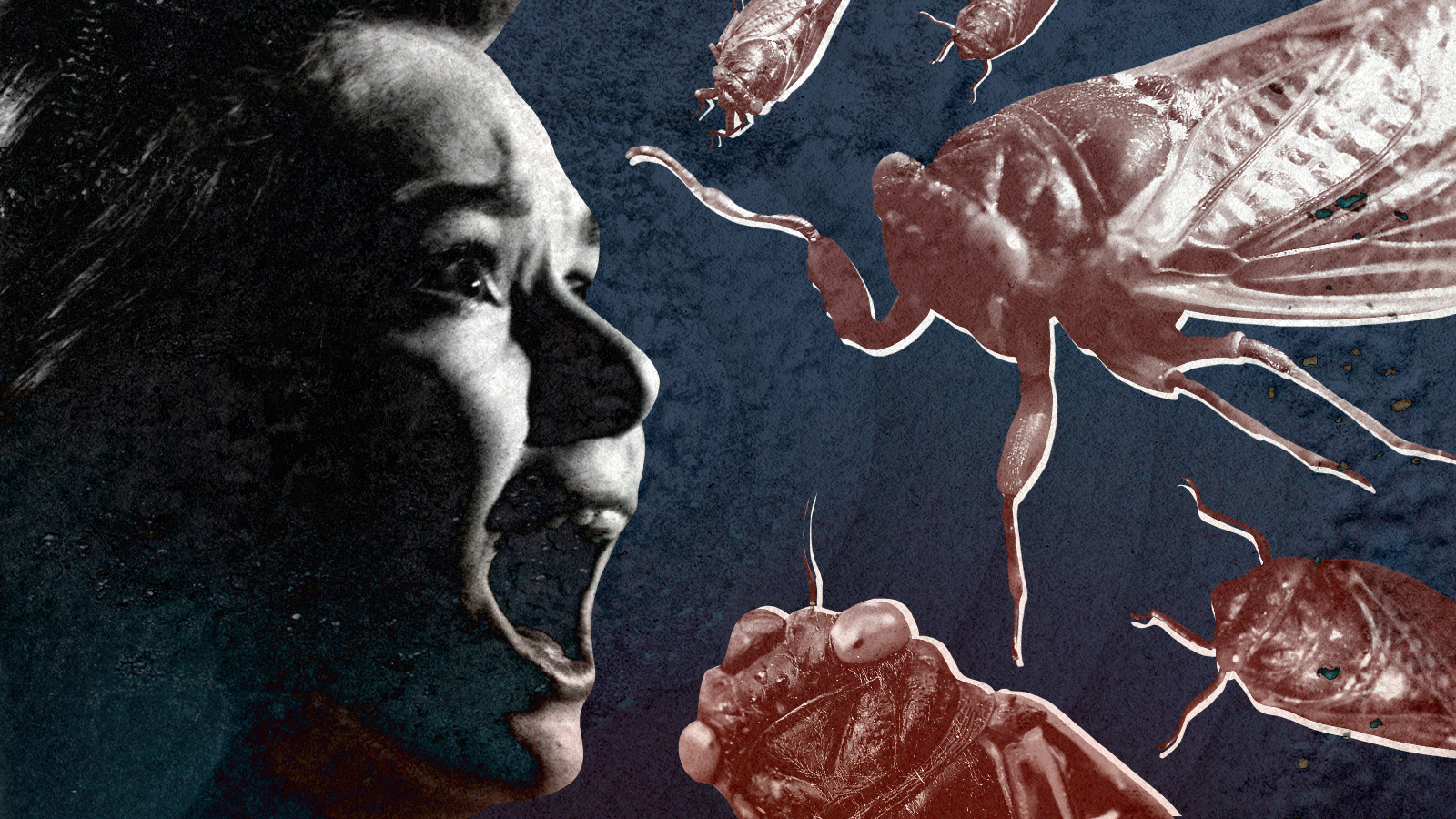Why insects are the perfect horror-movie villain
The scariest thing about bugs is just how human-like they really are


The video might best be described as a horror movie. Though it's less than 10 seconds long in total, the TikTok, posted by best.mom.ever79, has a jump scare — in the form of an unexpected screech that, with my headphones on, made me practically leap out of my skin — and even its own red-eyed monster.
Or, well, a lot of them. The cicadas are here, the neon text overlay explains.
You can find similar cicada videos all over TikTok as Brood X nears the end of its two-month-long emergence. In part, it is the swarm's unrivaled size that makes it such an object of our fascination and revulsion: The emergence stretches across at least 15 states, and could number in the trillions. The bugs outnumber the human population by up to 20,000-to-1. There are so many of them that their swarm appeared on weather radars earlier this month, like a massive, living raincloud. They're responsible for at least one crashed car and a grounded plane. They've attacked our leader.
The Week
Escape your echo chamber. Get the facts behind the news, plus analysis from multiple perspectives.

Sign up for The Week's Free Newsletters
From our morning news briefing to a weekly Good News Newsletter, get the best of The Week delivered directly to your inbox.
From our morning news briefing to a weekly Good News Newsletter, get the best of The Week delivered directly to your inbox.
Blessedly, they don't have the mental capacity to actually organize themselves against us. But the thrill we get from watching and filming and sharing videos of the cicadas speaks to a larger, almost primordial obsession we have with insects at large. The visibility of their deaths all around us — as we crush them beneath our feet, swat them with a rolled-up magazine, or exterminate them with the ease of a thumb on a can of RAID — is distilled in our creation of such entomological horror movies, where it becomes explicit that their brutally short lives might yet be more durable than our own.
Our earliest forms of art demonstrate our species' longstanding connection to the lives of bugs. Our ancestors traced scorpions in the stars and copied down their images in cave drawings between 12,000 and 40,000 years ago; they used bees' likeness in ancient adornments and turned to insects as a source of medicine. We wove six-legged creatures into our stories and mythologies, from the ancient Greek poets who wrote odes to cicadas to the story of Gregor Samsa, whose metamorphosis into an Ungeziefer — most commonly translated from the German as "a giant insect" — is taught in high school English classrooms every year.
And when we eventually invented movie cameras, we started filming bugs too: alive, as in The Acrobatic Fly (1910), which marvels at the physical capabilities of a housefly, as well as dead, like the stop-motion characters used in The Insect's Christmas, an unintentionally macabre film from 1913. Because immobile bugs proved easier to film, we soon started making models and animations of insects for movies instead of relying on live subjects.
And those models eventually started to get bigger. Much bigger.
A free daily email with the biggest news stories of the day – and the best features from TheWeek.com
Atomic anxiety brought Japan Godzilla. In America, this anxiety manifested in "giant bug" movies like Tarantula, Earth vs. the Spider, The Deadly Mantis, and 1954's Them! In the latter film, ants near an atomic bomb testing site in New Mexico mutate to grow to an enormous size; naturally, they begin terrorizing cities across the southwest. Though the two large-scale ants built for the movie might look a little cheesy to our modern eyes, the bugs were a hit with contemporary audiences, basically single-handedly rejuvenating the sci-fi genre and giving Warner Bros its highest-grossing film of the year.
Them! ends with a particularly on-the-nose warning: "When man entered the atomic age, he opened a door into a new world. What we'll eventually find in that world, nobody can predict." But while it's easy to read the film as a cautionary tale about how easy it's become to extinguish people the same way we once did six-legged vermin, as scholar W. Tsutsui wrote in his paper Looking Straight at Them! Understanding the Big Bug Movies of the 1950s, the film could also very well have been based in our "actual fears of an insect invasion and growing misgivings about the safety and effectiveness of modern insecticides in 1950s and early 1960s America."
Yes, but really, ants? While they might not seem like the obvious monster to turn to when we live in a world full of lions and sharks, it is exactly the mundanity of this monster that makes Them! work so well. "A fire-breathing dinosaur is a one-off, after all, bad luck," Syfy explains. "But a mutant ant? That could happen anywhere."
Insects, after all, are the perfect villain. Their faces are inscrutable, betraying no trace of emotion or thought whatsoever. They operate on pure instinct, to the point of nearly being robotic. They're also — as the scientist in Them! reminds us — "the only creatures on Earth other than man who make war."
The more we learn about insects, the more frighteningly human our tiny, numerous neighbors actually seem. As Jonathan Meiburg writes in his new book, A Most Remarkable Creature (which is as satisfying an entomological read as it is an ornithological one), "Peering into the world of ant societies" — for example — "can induce a kind of cognitive vertigo, if not full-blown identity crisis, since it's hard to find a complex human behavior ants don't pursue with equal of greater vigor — including architecture, farming, division of labor, and warfare." Even the "us" in Them! is eventually made explicit in the way the human soldiers, once their gas masks are on, appear as machine-like and unreadable as the ants, crawling through the subterranean sewers beneath Los Angeles like it was their nest.
The Hellstrom Chronicle, a 1971 nonfiction film masquerading as a fictional doomsday prophecy, raises the same question with its audiences. "Is it possible," its made-up scientist, Nils Hellstrom, wonders, "that these creatures are us?"
The Hellstrom Chronicle is an immensely odd movie, written by The Omen author David Seltzer, with lots of similar philosophizing in its voice-over; The New York Times dismissed the narration as "asinine," though the film went on to win the documentary Oscar. And while the movie touches on the nuclear anxiety of the big bug movies of the 1950s by dwelling on insects' seeming imperviousness to our most fearsome instruments of death, it also gestures to something far more Biblical and preordained: Insects had a 300 million "head start on man," Dr. Hellstrom points out, and "if any living species is to inherit the Earth," it won't be us. A decade after Rachel Carson's Silent Spring, he further stresses to audiences that "in fighting the insect, we're killing ourselves."
Entomological horror has shifted as this revelation has become clearer in light of findings about climate change and our current mass extinction event. While in 1971 it might have been true when Dr. Hellstrom pointed out that man and insect are the only two creatures on this planet increasing in number, that is no longer the case: the apocalypse has come not for us, at least not initially — but for the insect. With a few caveats, bugs are understood to be declining at a rate of extinction eight times faster than that of birds, mammals, or reptiles. "Unless we change our ways of producing food, insects as a whole will go down the path of extinction in a few decades," one group of scientists warned in 2019. "The repercussions this will have for the planet's ecosystems are catastrophic to say the least."
That is at least partially the preoccupation of Syfy's Locusts: The 8th Plague, a 2005 film about scientists who try to engineer locusts to eat other bugs but instead create a bloodthirsty swarm that kills unsuspecting Midwesterners by flying through them. Though the film itself is deliberately campy, the underlying reminder today is the same as it was when Hollywood was making films about oversized ants: Don't mess with nature, or it will lead to our own demise.
At the same time, Locusts gets to the heart of a decidedly less existential fear, one familiar to anyone who's ever had to deal with the domestic horror of an infestation of ants or cockroaches or fleas or bedbugs or termites or fruit flies: that we are only masters of our domains symbolically. As soon as insects decide they want to invade our spaces, it can be nearly impossible to tell them otherwise.
Insects don't need to be enlarged or linked to an end-times message to scare us, after all. An ant, viewed closely, will move with the same monstrous rigidity of the models in Them!, and you don't need David Attenborough to describe cicadas as "zombies" to be chilled by their emergence from the soil.
On TikTok, too, there's the same implicit reminder every time an iPhone cameraman expresses surprise or disgust over the magnitude of Brood X. As the Jungian psychologist James Hillman hypothesized about our all-too-common fear of six-legged critters, "imagining insects numerically threatens the individualized fantasy of a unique and unitary human being … [and] indicate insignificance of us as individuals." It's true that there's something terrifying about the knowledge that such creatures have slumbered beneath our feet these past 17 years, all the while unaffected by our trivial dramas, our fleeting lives. (Or our births: "I wasn't alive the last time the cicadas emerged" is a constant refrain among TikTok's young filmmakers).
While it might seem foolish to fear the cicada, which is so defenseless that its only protection is its sheer number, it would also be foolish not to respect it. Shakespeare famously wrote "as flies to wanton boys are we to the gods," but maybe he had it backward. Wanton boys eventually grow old and die — but as our ancestors recognized, as Hollywood has mined for thrills, and as each new generation discovers 17 years after having forgotten — the real horror of insects is realizing, with admiration and the soft little thrill of a memento mori, that they might be the ones who are more akin to gods than we are.
Jeva Lange was the executive editor at TheWeek.com. She formerly served as The Week's deputy editor and culture critic. She is also a contributor to Screen Slate, and her writing has appeared in The New York Daily News, The Awl, Vice, and Gothamist, among other publications. Jeva lives in New York City. Follow her on Twitter.
-
 A fentanyl vaccine may be on the horizon
A fentanyl vaccine may be on the horizonUnder the radar Taking a serious jab at the opioid epidemic
-
 The 8 best comedy TV series of 2025
The 8 best comedy TV series of 2025the week recommends From quarterlife crises to Hollywood satires, these were the funniest shows of 2025
-
 Codeword: December 16, 2025
Codeword: December 16, 2025The daily codeword puzzle from The Week

